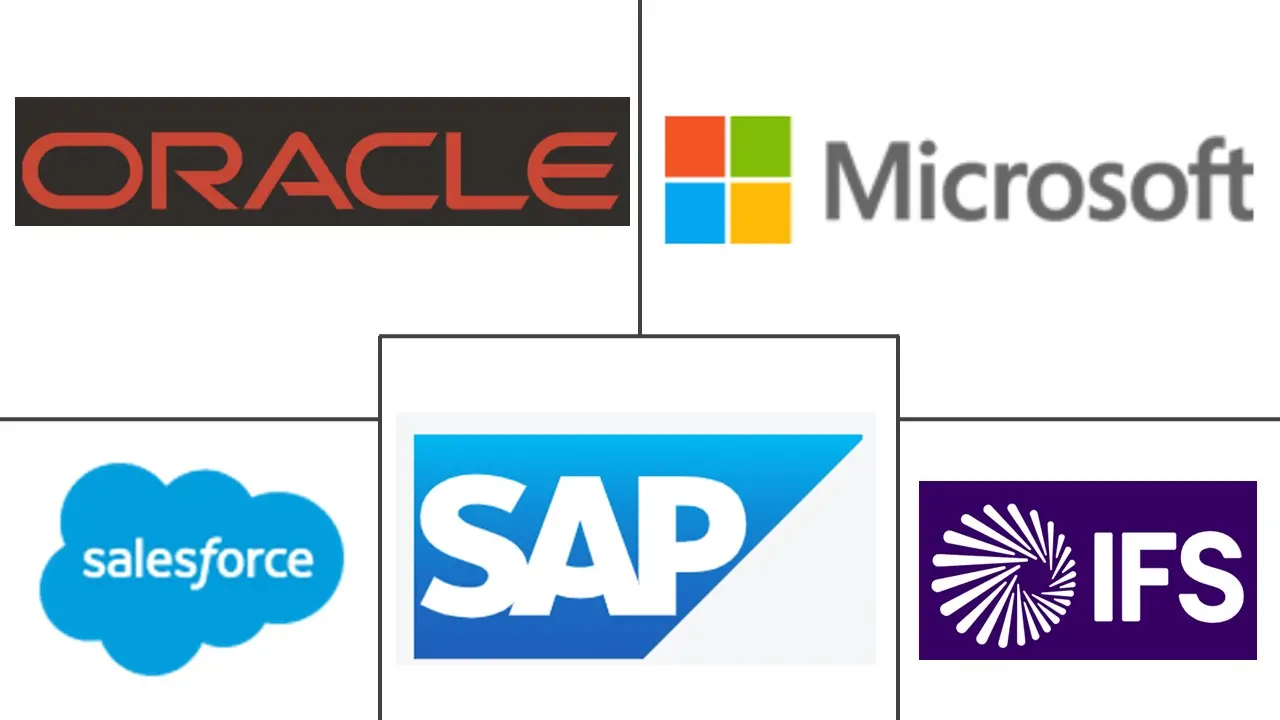Field Service Management (FSM) Market Size and Share
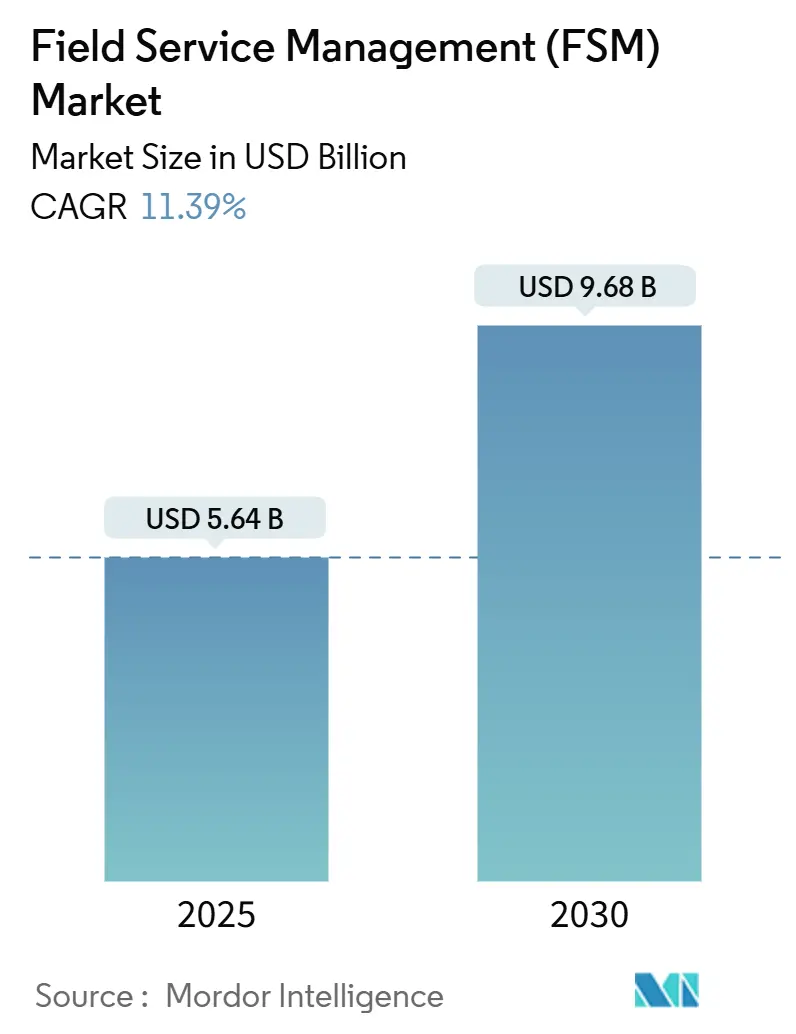
Field Service Management (FSM) Market Analysis by Mordor Intelligence
The field service management market size is valued at USD 5.64 billion in 2025 and is forecast to expand to USD 9.68 billion by 2030, reflecting an 11.39% CAGR. Growth stems from rapid adoption of AI-assisted scheduling, IoT-enabled predictive maintenance, and 5G-powered connectivity that jointly compress service cycle times and improve first-time fix rates. Organisations are shifting workloads to the cloud to secure flexibility, lower capital expense, and easier integrations, while advanced analytics reshape technician dispatch and inventory planning. Vendors are widening partner ecosystems to accelerate implementation services and industry-specific extensions, opening fresh revenue pools for both software and services providers. The field service management market also benefits from recurring revenue models such as Equipment-as-a-Service, which convert one-time product sales into long-life service contracts and lock in customer relationships.
Key Report Takeaways
- By deployment type, on-premise solutions retained 57% of the field service management market share in 2024, whereas cloud deployment is projected to grow at a 14.2% CAGR to 2030.
- By organisation size, large enterprises accounted for 66% share of the field service management market in 2024, while SMEs are advancing at a 13.5% CAGR through 2030.
- By solution & service grouping, software solutions represented 61% of the field service management market size in 2024; services are expected to register the fastest 14.8% CAGR between 2025-2030.
- By end-user vertical, manufacturing led with 22% revenue share in 2024, whereas transportation & logistics is forecast to expand at a 15.6% CAGR to 2030.
- By geography, North America held a 34% share of the field service management market in 2024; Asia-Pacific is the fastest-growing region at a 15.2% CAGR over the same horizon.
Global Field Service Management (FSM) Market Trends and Insights
Drivers Impact Analysis
| Driver | (~) % Impact on CAGR Forecast | Geographic Relevance | Impact Timeline |
|---|---|---|---|
| Real-time Technician Visibility Needs across Utilities and Telecom | +2.1% | Global, with higher impact in North America and Europe | Medium term (2-4 years) |
| Large-scale 5G Roll-outs Raising Field Complexity | +1.8% | North America, Europe, Advanced APAC markets | Short term (≤ 2 years) |
| Decarbonization Push Driving Smart-Meter and EV-Charger Installs | +1.5% | North America, Europe, Urban APAC | Medium term (2-4 years) |
| Ageing Workforce Accelerating AI-assisted Scheduling | +2.3% | Global, with higher impact in developed economies | Long term (≥ 4 years) |
| OEM Servitization Models Creating Recurring Revenue Streams | +1.7% | Global, with initial adoption in North America and Europe | Medium term (2-4 years) |
| Remote-work Safety Rules Fueling AR-based Remote Assistance | +1.2% | Global, with higher adoption in technologically advanced regions | Short term (≤ 2 years) |
| Source: Mordor Intelligence | |||
Real-time Technician Visibility Needs across Utilities And Telecom
Utilities and telecom operators are under pressure to cut outage durations and meet rising customer expectations. Field platforms that stream live location, job status, and asset data shorten decision cycles, delivering 30-40% time savings in live deployments [1]GSMA Intelligence, “How 5G Is Transforming APAC,” gsma.com. IoT-enabled condition monitoring reduces truck rolls by prioritising genuine failure risks, while integrated mobile apps surface checklists, schematics, and parts availability onsite. Broader roll-out is set to intensify as grid modernisation programmes and fibre upgrades multiply asset points needing service.
Large-scale 5G Roll-outs Raising Field Complexity
5G macro- and small-cell densification multiplies network elements, making route planning and spares management far more intricate. Telecom field teams now access high-definition video support and AR overlays via the same 5G links they install, letting junior technicians handle advanced tasks with remote expert guidance [2]T-Mobile for Business, “AR-Enhanced 5G Field Service Solutions,” t-mobile.com. As coverage accelerates, operators demand field service management market solutions that can orchestrate thousands of sites per region and balance outsourced crews with in-house staff.
Decarbonisation Push Driving Smart-Meter & EV-Charger Installs
Government incentives and corporate net-zero pledges are spurring the mass deployment of smart meters and public EV chargers. Programmes such as the Energised Communities initiative allocate up to USD 250,000 per locality for charger roll-outs [3]Clean Power Alliance, “Energised Communities Program Factsheet,” cleanpoweralliance.org. Coordinating these multi-site projects calls for advanced scheduling, contractor dispatch, and materials tracking capabilities native to modern field service management market platforms. Embedded IoT support ensures that once installed, devices remain online and self-report anomalies.
Ageing Workforce Accelerating AI-assisted Scheduling
Half the global technician pool is heading toward retirement, and gig-based workers fill the gap. AI engines that score skill, location, and SLA urgency are boosting first-time fix rates while improving job satisfaction through balanced workloads. Integrated knowledge bases and AR step-through guides transfer expertise in the moment. Organisations adopting these tools safeguard service quality despite shrinking talent pipelines, anchoring long-term demand within the field service management market.
Restraints Impact Analysis
| Restraint | (~) % Impact on CAGR Forecast | Geographic Relevance | Impact Timeline |
|---|---|---|---|
| Cyber-security and Data-sovereignty Barriers in Public Sector | -1.3% | Global, with higher impact in EU and APAC | Medium term (2-4 years) |
| Legacy ERP/OT Integration Complexity in Brownfield Plants | -1.2% | Global, with higher impact in mature industrial markets | Short term (≤ 2 years) |
| Up-front Subscription and Change-management Costs for SMEs | -0.9% | Global, with higher impact in emerging markets | Short term (≤ 2 years) |
| Cross-border Regulatory Fragmentation Hindering AI Dispatch | -1.1% | Global, with higher impact in regions with strict data regulations | Medium term (2-4 years) |
| Source: Mordor Intelligence | |||
Cyber-security & Data-sovereignty Barriers in Public Sector
Utilities, transport agencies, and healthcare providers must keep operational data inside national borders and comply with stringent breach-notification laws. Frameworks such as the European Data Governance Act mandate localisation and proof of control, often delaying cloud FSM deployments. Vendors with region-specific hosting, granular access controls, and certified encryption overcome these hurdles fastest.
Legacy ERP/OT Integration Complexity in Brownfield Plants
Brownfield manufacturers run decades-old PLCs and bespoke ERP modules that lack modern APIs. Linking these assets to mobile work-order flows inflates project cost by up to 40% and lengthens timelines by half. Pre-built connectors, low-code integration hubs, and plant-floor gateways therefore sit high on buyer checklists within the field service management market.
Segment Analysis
By Deployment Type: Cloud Adoption Accelerates Despite On-Premise Dominance
On-premise installations held 57% of the field service management market in 2024, reflecting sunk infrastructure and tight data-control policies among large enterprises. The field service management market size linked to on-premise deployments will still expand, albeit slowly, as maintenance of existing estates persists through the decade.
Cloud platforms, however, are growing at a 14.2% CAGR and capture most net-new projects. Lower start-up costs, rapid provisioning, and automatic feature updates appeal to organisations scaling mobile workforces. API-rich environments simplify integration with CRM, ERP, and IoT stacks, gradually eclipsing bespoke on-premise customisations.
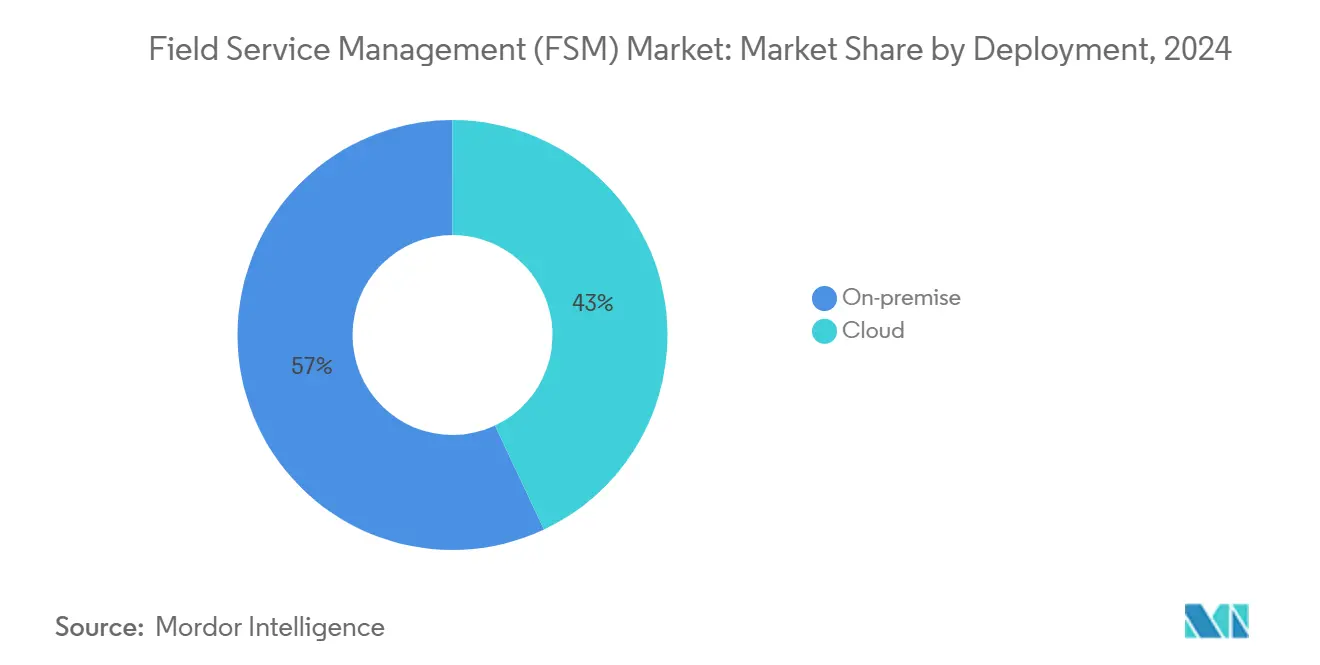
By Organisation Size: SMEs Embrace Digital Transformation
Large enterprises commanded 66% revenue in 2024 thanks to global service footprints and complex multi-brand asset portfolios. These accounts often layer field service management market analytics atop base scheduling to drive continuous improvement across regions.
SMEs are the fastest-growing cohort at 13.5% CAGR. Affordable SaaS editions and guided onboarding demystify adoption. Once core work-order flows mature, midsize firms add IoT telemetry and customer portals, widening the field service management market size while proving ROI through reduced travel and quicker invoice cycles.
By FSM Solution and Service Type: Services Outpace Software Growth
Software modules - dispatch, route optimisation, work-order, and customer portals - comprised 61% of revenue in 2024. Scheduling engines remain the anchor because they visibly boost technician utilisation within months, locking in platform stickiness.
Professional services revenue is rising 14.8% per year as clients seek integration, change management, and analytics tuning. Vendor-delivered accelerators connect FSM suites to ERP, warranty, and parts-planning systems, ensuring that field service management market deployments achieve promised KPIs. Continuous improvement retains then refines AI models and mobile UX.
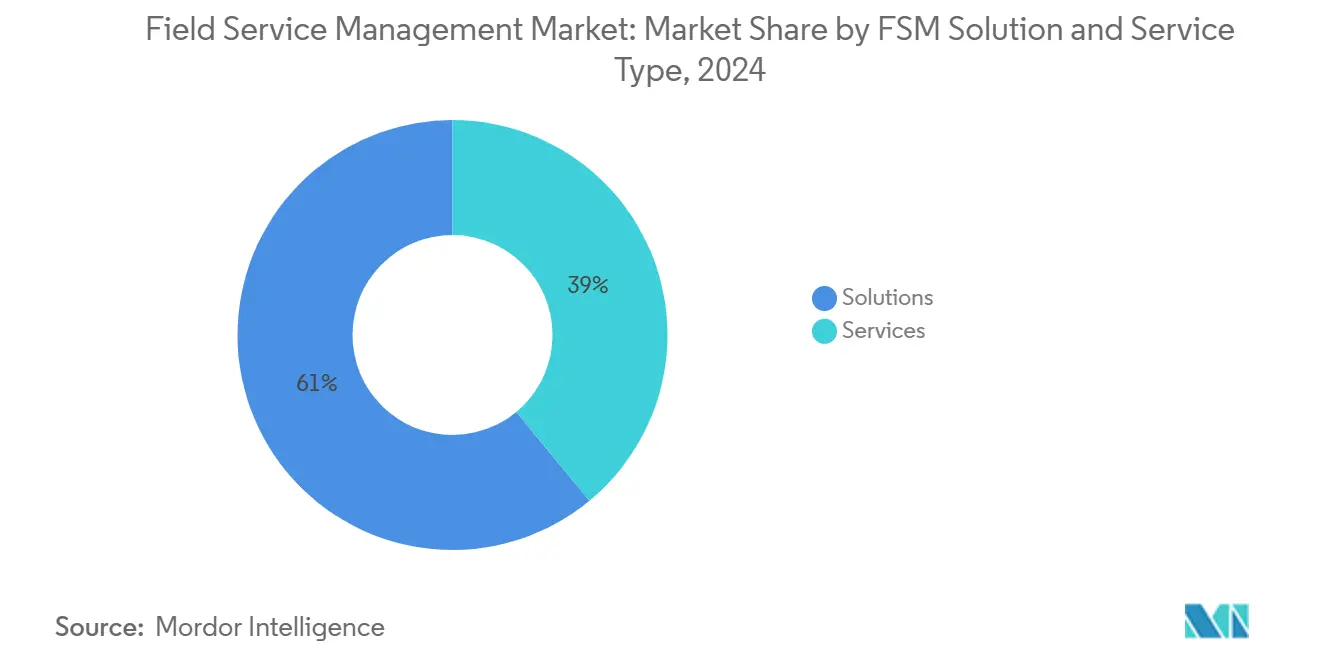
By End-User Vertical: Transportation & Logistics Lead Growth
Manufacturing accounted for 22% of the field service management market share in 2024, reflecting extensive preventive maintenance across shop-floor assets and strict uptime goals. Predictive insights cut unplanned downtime, making FSM integral to Industry 4.0 roadmaps.
Transportation and logistics are accelerating at 15.6% CAGR. Route optimisation, driver mobile apps, and predictive maintenance for fleets deliver up to 25% cost savings, spurring rapid platform uptake. The field service management market size generated by this sector will therefore climb sharply as e-commerce volumes drive tighter delivery SLAs.
Geography Analysis
North America generated 34% of global revenue in 2024, sustained by early adopter enterprises and well-developed partner ecosystems. Service providers face mounting labour shortages—one quarter of construction staff exceed 55 years of age, which intensifies demand for AI scheduling and contractor marketplaces. Cloud adoption also rises as enterprises standardise on North America–hosted SaaS environments to centralise governance.
Asia-Pacific is expanding at a 15.2% CAGR. Industrialising economies digitise field work to offset rising wages, while advanced nations deploy private 5G and drones to reach remote assets. In Hong Kong, a 5 G-AR pilot delivered 30-40% task-time reductions, proving ROI for broader regional roll-outs. Government smart-city grants further accelerate spending on asset-centric field service management market applications.
Europe holds a substantial share, driven by manufacturing and utilities. Strict GDPR rules elevate data-residency and encryption demands, nudging some buyers toward local or hybrid deployments. Sustainability mandates also shape vendor selection, with route optimisation prized for lowering fleet emissions. Initiatives such as GAIA-X boost sovereign-cloud offers, enabling compliant scaling of the field service management market across EU borders.
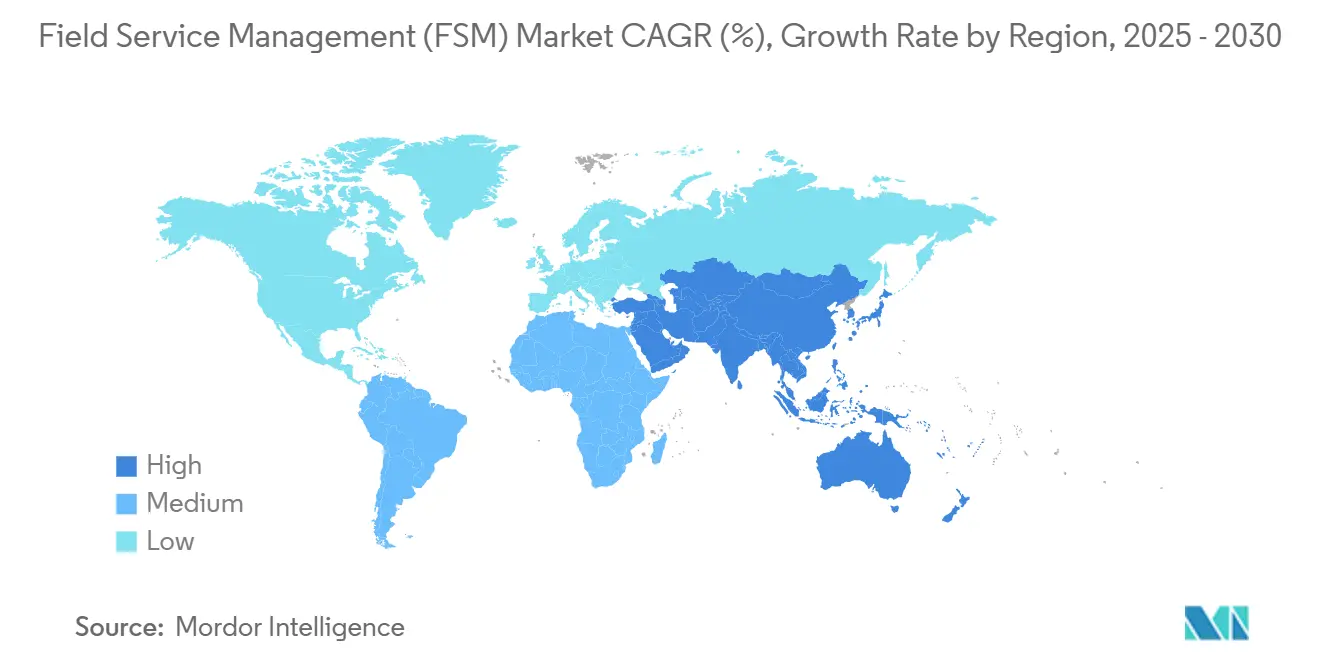
Competitive Landscape
The market is moderately fragmented. Enterprise application vendors—Microsoft, Oracle, SAP, Salesforce - bundle FSM into broader suites, appealing to CIOs seeking platform consolidation. Best-of-breed specialists, including IFS, ServiceMax, FieldAware, and emerging player Zuper, compete through deeper mobile UX and industry templates.
M&A activity continues. IFS added asset management and aviation modules through its Copperleaf and EmpowerMX purchases in 2024, lifting annual recurring revenue beyond EUR 1 billion [4]IFS, “IFS Year in Review 2024,” ifs.com. PTC introduced ServiceMax AI to embed generative recommendations inside technician workflows, exemplifying the shift toward embedded intelligence.
Partner ecosystems matter more each year. Implementation firms build accelerators that shrink deployment time, while hardware makers integrate rugged devices and AR headsets to optimise performance under harsh conditions. Vendors that orchestrate these alliances effectively expand wallet share inside the field service management market.
Field Service Management (FSM) Industry Leaders
-
Oracle Corp. (Oracle Field Service)
-
Salesforce Inc. (Field Service)
-
Microsoft Corp. (Dynamics 365 Field Service)
-
SAP SE (Coresystems)
-
IFS AB
- *Disclaimer: Major Players sorted in no particular order
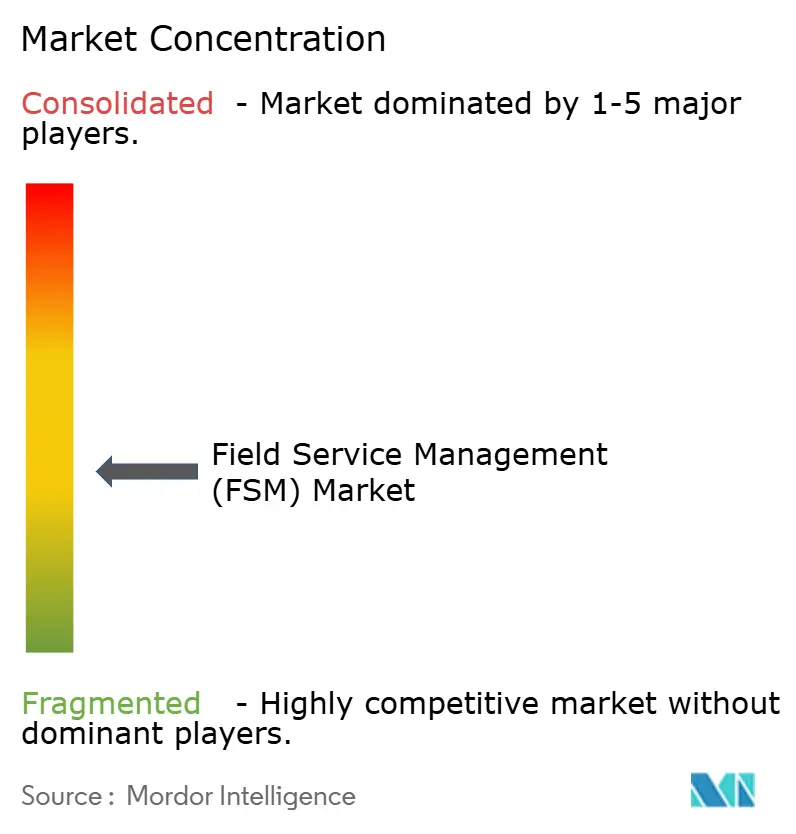
Recent Industry Developments
- May 2025: Zuper was named an IDC Innovator in field service management applications, spotlighting its AI-powered cloud platform and 60+ integrations.
- April 2025: The IFS Annual Report revealed EUR 1 billion (USD 1.16 billion) ARR and a 32% YoY surge, underpinned by FSM acquisitions.
- February 2025: PTC unveiled ServiceMax AI, a generative assistant that surfaces asset history, drafts service notes, and predicts maintenance windows.
- February 2025: Clean Power Alliance launched the Energised Communities Program, offering USD 250,000 per community for EV charging and building electrification projects.
Research Methodology Framework and Report Scope
Market Definitions and Key Coverage
Our study defines the field service management market as the annual revenues generated by purpose-built software platforms (and associated integration or support services) that plan, dispatch, track, and analyze mobile technicians who install, repair, or maintain customer assets. Solutions span scheduling, work-order orchestration, route optimization, contract and inventory control, plus real-time mobile apps that feed operational analytics.
Scope exclusion: Hardware such as rugged devices, vehicle telematics boxes, and standalone GPS trackers is not counted.
Segmentation Overview
- By Deployment Type
- On-premise
- Cloud
- By Organization Size
- Large Enterprises
- Small and Medium Enterprises
- By FSM Solution and Service Type
- Solutions
- Scheduling, Dispatch and Route Optimization
- Service Contract Management
- Work-order Management
- Customer Management
- Inventory Management
- Other Software (Billing, Invoicing, Warranty)
- Services (Integration, Implementation, Support)
- Solutions
- By End-User Vertical
- Facilities Management (Hard-FM and Soft-FM)
- IT and Telecom
- Healthcare and Life Sciences
- Energy and Utilities
- Oil and Gas
- Manufacturing
- Transportation and Logistics
- Real Estate and Others
- By Geography
- North America
- United States
- Canada
- Mexico
- South America
- Brazil
- Argentina
- Chile
- Peru
- Rest of South America
- Europe
- Germany
- United Kingdom
- France
- Italy
- Spain
- Rest of Europe
- Asia-Pacific
- China
- Japan
- South Korea
- India
- Australia
- New Zealand
- Rest of Asia-Pacific
- Middle East and Africa
- United Arab Emirates
- Saudi Arabia
- Turkey
- South Africa
- Rest of Middle East and Africa
- North America
Detailed Research Methodology and Data Validation
Primary Research
Mordor analysts interviewed product managers at major FSM vendors, digital transformation leads in utilities, and fleet supervisors across North America, Europe, and Asia Pacific. These dialogs clarified license fee bands, cloud migration pacing, and real-world churn, filling the gaps left by desk work and sharpening model assumptions.
Desk Research
We began with public datasets from bodies such as the US Bureau of Labor Statistics, Eurostat, India's MeitY digital index, and OECD ICT spending tables, which reveal technician head-count trends and enterprise software outlay. Trade associations, for example, CompTIA and the International Facility Management Association, provide adoption rates for mobility tools, while patent query snapshots from Questel highlight innovation velocity in AI-driven scheduling. Company 10-Ks, investor decks, and credible press releases then anchor vendor revenue splits. Paid screens from D&B Hoovers and Dow Jones Factiva let us verify corporate disclosures. This source list is illustrative; many additional references were reviewed for validation.
Market-Sizing & Forecasting
A top-down rebuild starts with regional technician pools, enterprise software budget ratios, and cloud penetration rates; results are corroborated with selective bottom-up checks such as sampled average selling price multiplied by live user counts reported during interviews. Key inputs include: 1) number of field workers per sector, 2) share of technicians on mobile apps, 3) average annual license plus support fee per user, 4) cloud share progression, 5) regional GDP outlook, and 6) regulatory pushes for digital work orders. Multivariate regression blends these variables, and scenario analysis captures macro shocks. Where supplier roll-ups miss micro-segment detail, interpolation rules guided by contract size distribution smooth the gaps.
Data Validation & Update Cycle
Outputs pass variance tests against spend benchmarks, with anomalies escalated to a senior reviewer before sign-off. Reports refresh each year; interim updates occur when sizable policy, merger, or pricing events surface, and a rapid client-ready sweep is completed prior to delivery.
Why Mordor's Field Service Management Baseline Merits Confidence
Published figures often diverge because firms disagree on whether to include implementation services, how quickly cloud displaces on-premise, and the speed at which SMEs adopt.
Our disciplined scope, live ASP verification, and yearly refresh cadence temper extremes and keep currency conversions consistent.
Benchmark comparison
| Market Size | Anonymized source | Primary gap driver |
|---|---|---|
| USD 5.64 B (2025) | Mordor Intelligence | - |
| USD 4.00 B (2023) | Global Consultancy A | Uses historic base, excludes support services, assumes slower cloud shift |
| USD 4.72 B (2024) | Industry Association B | Counts license revenue only, no inflation normalization |
| USD 4.91 B (2023) | Regional Consultancy C | Limited geographic coverage, single-scenario forecast |
These comparisons show that when scope breadth, variable rigor, and refresh frequency vary, market values move materially; Mordor's balanced, traceable approach supplies decision-makers with a dependable starting point.
Key Questions Answered in the Report
What is the projected value of the field service management market by 2030?
The field service management market is forecast to reach USD 9.68 billion by 2030, rising at an 11.39% CAGR.
Which deployment model is growing fastest?
Cloud-based platforms are expanding at a 14.2% CAGR thanks to lower capital cost, faster roll-out, and easier integration.
Why is transportation & logistics the fastest-growing vertical?
Companies in this sector use route optimisation and predictive fleet maintenance to cut costs by up to 25%, producing a 15.6% CAGR for field service management solutions.
How are ageing technicians influencing technology adoption?
Retirements create skills gaps, prompting firms to deploy AI scheduling and AR knowledge transfer tools that boost first-time fix rates and preserve expertise.
Which region offers the highest growth potential?
Asia-Pacific leads with a 15.2% CAGR as industrialising economies embrace cloud FSM, 5G, and IoT to lift service productivity.
How does servitisation impact OEM revenue models?
By bundling maintenance into subscription or outcome-based contracts, OEMs generate 2-3 times higher margins and secure long-term customer relationships, relying on robust field service management platforms to manage uptime guarantees.
Page last updated on:
